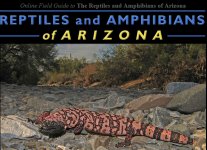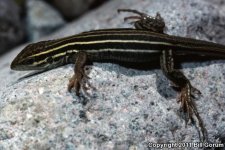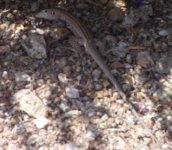| Range: |
 |
| Other Names: |
|
| Description: |
A small to medium-sized (up to 89 mm or 3.5" from snout to vent), slim, brown to black lizard with a long, thin tail, and a slim, pointed snout. The body is marked with six yellow to cream stripes and relatively few light spots. There area between the two central dorsal stripes usually lacks spots. The tail is olive to brown. The underside is plain and pale. Juveniles lack spots. The scales on the body are small and granular. The scales on the tail are large, keeled, and rectangular. The belly scales are large, smooth, and rectangular. The scales on top of the head are large, smooth, and plate-like. |
| Similar Species: |
The Sonoran Spotted Whiptail's distinct stripes (particularly on the neck) and relatively spare spotting distinguish it from the similar looking Chihuahuan Spotted Whiptail. Its olive-brown tail and lack of spots between the two central dorsal stripes distinguish the Sonoran Spotted Whiptail from the similar looking Canyon Spotted Whiptail. |
| Venom: |
None |
| Habitat: |
Inhabits communities ranging from Semidesert Grassland, through Madrean Evergreen Woodland, to Petran Montane Conifer Forest. It also follows riparian corridors down into Chihuahuan Desertscrub and Arizona Upland Sonoran Desertscrub in some areas. Found in a variety of terrain types including steep rugged canyons, rolling wooded hills, and relatively flat, open, low valleys. Often encountered along drainages and riparian corridors. |
| Behavior: |
This is an alert, diurnal, fast-moving ground-dweller. It is often encountered foraging or basking in the mid-morning sun. It actively forages by rooting around in organic matter under bushes and by digging in the soil around the bases of rocks and other surface debris. |
| Hibernation: |
Adults often go into hibernation in late summer. Juveniles remain active until fall. Both adults and juveniles emerge from hibernation in spring. |
| Reproduction: |
All Sonoran Spotted Whiptails are female (parthenogenetic). Eggs are unfertilized and hatchlings are clones of the mother. Clutches of 1 to 7 eggs are laid in late spring or summer. Hatchlings begin to appear in late July. |
| Diet: |
It feeds on termites, spiders, beetles, ants, grasshoppers, and other invertebrates. |
Adapted from account on reptilesofaz.org
Sources:



|













